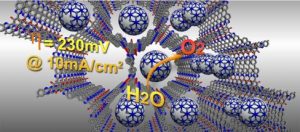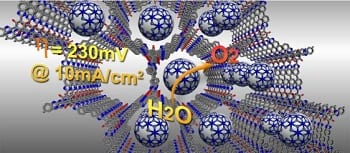Continuous demand for H2 and O2, two clean and efficient fuels, has created a need to find low-energy routes for producing them. ‘Water-splitting‘ is a chemical reaction wherein water can be broken into its components in a catalyzed process. In practical water splitting, excess potential is required over the thermodynamic limit. This excess is termed ‘overpotential’. An overpotential of 300 mV at a current density of 10 mA cm-2 (h10) benchmarks a good electrocatalyst. The best ones are based on noble metals such as Ru, Ir and Pt. Thus catalysts derived from cheaper metals are required.
Covalent Organic Frameworks (COFs) are materials that resemble graphene, but carry an excellent additional advantage in the form of tunable modular structures and ordered porosity. This enables insertion of specific hetero atoms (N, S, P) via a ‘by design‘ approach, which can ensure stronger interaction with metal based nanoparticles hosted within their pores.
 Vaidhyanathan and co-workers, at IISER Pune, have developed COF supported nickel/cobalt based electrocatalysts. Exploiting the modular construction of COF, in one case, Dinesh Mullangi has introduced sp3 nitrogen centers into the COF and this gives rise to a highly crystalline but flexible COF (IISERP-COF2), two structural features that generally do not co-exist. While the periodic insertion of N-atoms in the COF favors strong interaction with the Ni(OH)2 and/or Co(OH)2 nanoparticles (nPs), the flexibility of the COF generates aptly sized pores that confines these compounds into very small nanoparticles. This composite shows exceptional electrocatalytic activity towards oxidizing alkaline water (h10 = 250mV).
Vaidhyanathan and co-workers, at IISER Pune, have developed COF supported nickel/cobalt based electrocatalysts. Exploiting the modular construction of COF, in one case, Dinesh Mullangi has introduced sp3 nitrogen centers into the COF and this gives rise to a highly crystalline but flexible COF (IISERP-COF2), two structural features that generally do not co-exist. While the periodic insertion of N-atoms in the COF favors strong interaction with the Ni(OH)2 and/or Co(OH)2 nanoparticles (nPs), the flexibility of the COF generates aptly sized pores that confines these compounds into very small nanoparticles. This composite shows exceptional electrocatalytic activity towards oxidizing alkaline water (h10 = 250mV).
To this target, Shyamapada Nandi designed another COF to have a p-conjugated Benzimidazole based framework (IISERP-COF3). The high degree of conjugation renders this COF as all-organic conducting framework. By nano-confining metallic Ni3N in IISERP-COF3 a right locale is provided for large electronic-synergy between the host and the guest. As anticipated, this material oxidizes water with an even lower overpotential of h10 = 230 mV. The high activity is evident from the record-high amounts of O2 evolved (230 mmol h−1 g−1). This heralds the emergence of COF as apt support for electrocatalytic nanoparticles.

















